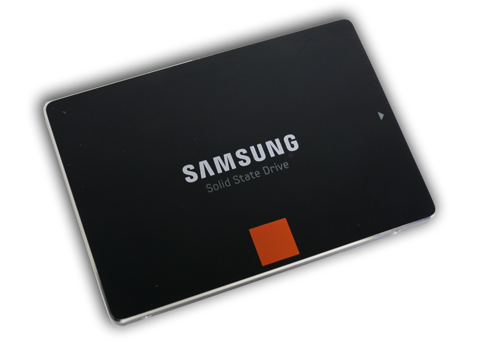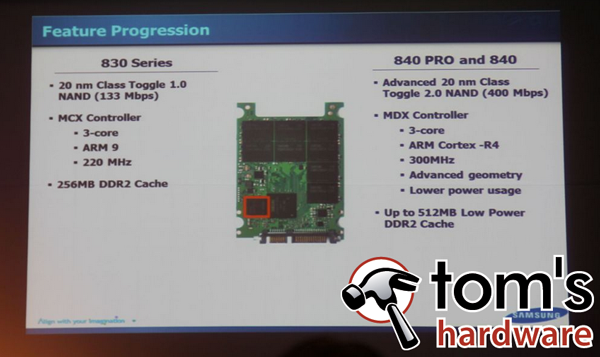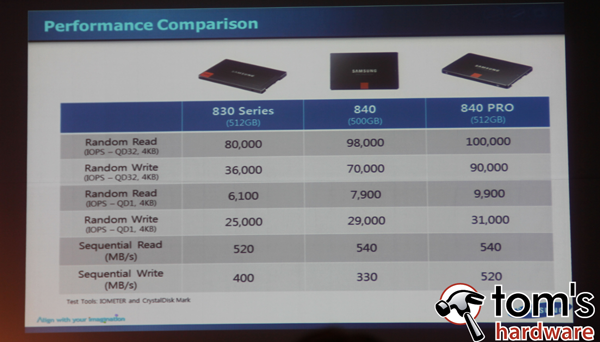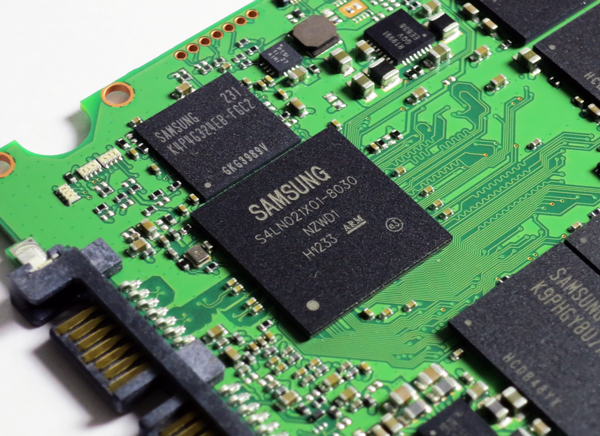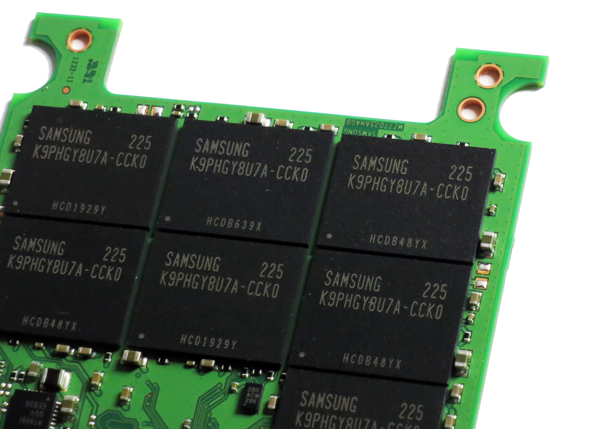Samsung 840 Pro SSD: More Speed, Less Power, And Toggle-Mode 2.0
Samsung 840 Pro: A New SSD Flagship
Once upon a time, new SSDs were rare enough that a launch was something big. Controller technology was changing. NAND process technology was shrinking. A new SATA interface was enabling mind-blowing performance improvements.
Not so much anymore, huh? Companies like SandForce and Marvell have made it easier to take a controller, buy some flash memory, slap on standard firmware, and sell your own SuperSequentialRandomRocket solid-state drive.
On one hand, that's actually good news. More competition means SSD vendors really have to fight for your business. And they do that with lower prices, longer warranties, bundles, and accessories. On the other, we're a lot more wary when a new drive hits one of our test beds with familiar component in it.
Fortunately, what we have in front of us today promises more excitement. We have new NAND, a new memory interface, and new firmware, at the very least, all packed into Samsung's new flagship client SSD, the 840 Pro.
The 840 Pro is designed to succeed Samsung's 830, a drive that earned notable praise during its tenure for consistent performance, often-aggressive pricing, and impressive power consumption. The company is claiming to raise the performance bar yet again, though, and it's going about that task in a handful of ways.
As of this writing, Samsung remains the only manufacturer with a SATA 6Gb/s-capable drive available at retail composed exclusively of its own building blocks. Isn't that a crazy thing to see almost a year after the 830 first emerged? Intel still doesn't have a 6 Gb/s controller. Crucial, which has access to Micron's NAND, employs Marvell controller hardware. Toshiba recently launched the THNSNF series using its own 19 nm flash and controller, but that remains an OEM-only family that we still haven't tested. Everyone else is using some combination of controllers and memory from other sources.
Although Samsung is in this unique position, it still has to contend with potent competition. The introduction of SSDs like OCZ's Vertex 4 and Plextor's M5 Pro pushed performance to never before seen heights without the influence of compression that all of the SandForce-based drives rely on for their big numbers.
Get Tom's Hardware's best news and in-depth reviews, straight to your inbox.
So, what's the big deal with the 840 Pro, then? As it turns out, Samsung is being a little coy about the specifications of its newest flagship. Not that we're surprised. The vendors with their own proprietary recipes tend to be the most tight-lipped about what makes their dishes taste good. Fortunately, just before today's announcement, the company chose to share a lot more information about its upcoming products at an SSD Summit in Korea, where we have a couple of Tom's Hardware representatives.
The 830 drives that launched last year featured a controller that Samsung called its MCZ, based on a triple-core ARM9-based design running at 220 MHz with an eight-channel NAND architecture. The 840 Pro being reviewed today and the 840 we'll be looking at soon both boast an updated MDX controller, also with an eight-channel architecture.
A transition to three ARM Cortex-R4 cores set to run at 300 MHz apparently gives the processor enough muscle to improve performance, even as Samsung enables new features like full-drive encryption via AES-256. Previously, that sort of functionality was limited to more enterprise-oriented SSDs.
The company's latest solid-state drive is also backed by up to 512 MB of LPDDR2-1066 cache; the 830 included 256 MB of LPDDR2-800.
Given its enthusiast-oriented position, Samsung is most actively discussing three capacity points for the 840 Pro: 128, 256, and 512 GB. Only the larger two models feature 512 MB of cache. The 128 GB version only comes with 256 MB.
The company also tells us there will be a 64 GB model as well, though it hasn't give us any detail about it.
And while it isn't giving us much detail about the other aspects of its latest design, Samsung is proud to reveal that the 840 Pro employs second-gen multi-level cell Toggle-mode DDR NAND with an interface rated for up to 400 Mb/s. That's about three times the data rate of Toggle-mode 1.0's interface.
Beyond this evolution, Samsung tells us it's manufacturing its second-gen Toggle-mode flash on a 21 nm lithography node. The company's previous-generation NAND was etched using a 27 nm process.
Our 512 GB sample includes eight ICs marked K9PHGY8U7A-CCK0. According to Samsung's decoder ring, the P indicates an MLC octal die configuration, while HG tells us that each package is 512 Gb (64 GB). So, we have eight 64 Gb die per package, yielding the 512 GB total capacity.
-
mayankleoboy1 Kudos to Samsung for getting ahead of the competition yet again. And the complete SSD is designed and manufactured in house! And thay are sure of its reliability, hence the 5 year warranty.Reply
I dont see why it did not get a Toms approved award.... its faster, uses less power, and offers better warranty than the competition. And the firmware is also stable, unlike SF. -
mayankleoboy1 Despite what the judges believe, Samsung is a great innovator. Unlike some fruity companies, that basically license other companies tech....Reply
-
willyroc Wow, Samsung was ahead of competitors with its 830 due to superior performance and low prices. Now I bet the 840 has, (or will) widened that lead.Reply -
pocketdrummer mayankleoboy1Kudos to Samsung for getting ahead of the competition yet again. And the complete SSD is designed and manufactured in house! And thay are sure of its reliability, hence the 5 year warranty. I dont see why it did not get a Toms approved award.... its faster, uses less power, and offers better warranty than the competition. And the firmware is also stable, unlike SF.Reply
Probably because it still costs $600 for a pathetic 512gb of memory. Once you can get 512gb for under $200 and have a life span that gets close to a decent HDD, then you can expect an award.
They keep increasing the speed, but they do nothing to reduce the COST. I would take an SSD half as fast as some that are out now if they cost me half as much and had a decent amount of storage. It's still pointless for someone like me who has over 1.5TB of space used. I can't load Windows and all of my critical programs on a 256GB SSD, and the 512GB wouldn't give me much wiggle room. Not to mention my sample libraries that would benefit from the speed... that are hundreds of GB each. -
So it's the Samsung 840Pro 256GB for C:, and it's the Seagate single-platter 1TB drive (ST1000DM003) for storage. Awesome awesome combo.Reply
-
sherlockwing Gah, 1 month after I get the 830 now comes the 840 Pro who gets another 120 mb/s in extra speed.Reply -
mayankleoboy1 sherlockwingGah, 1 month after I get the 830 now comes the 840 Pro who gets another 120 mb/s in extra speed.Reply
Thats technology growth for you :D -
sherlockwing To those that complain about SSD life span, the truth is that in 3 years(typical warranty of an SSD) you won't be using the same SSD because the new SSD will be 40-50% faster. 3 year from now I'd be using the 860 Pro with anyway and when an SSD reach end life it just can't write anymore, you can still read all the files onto your new SSD unlike a hard drive that just breaks down.Reply
